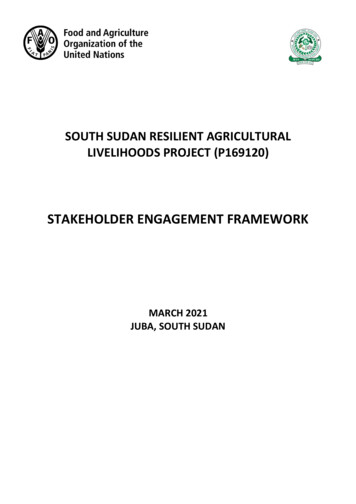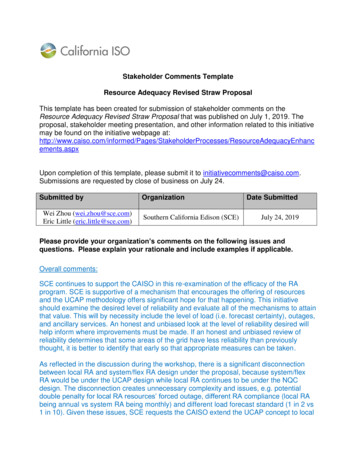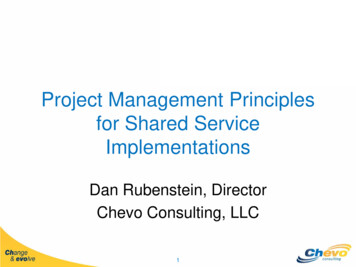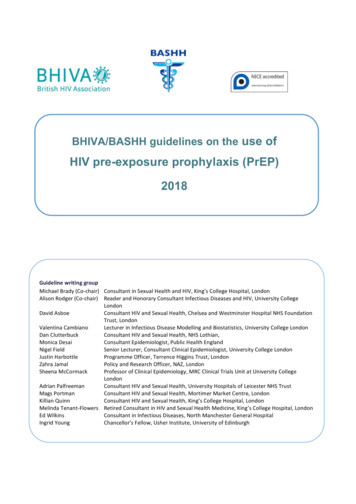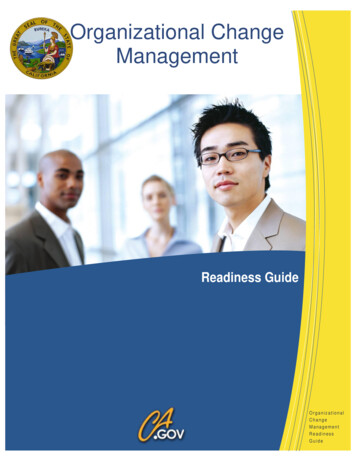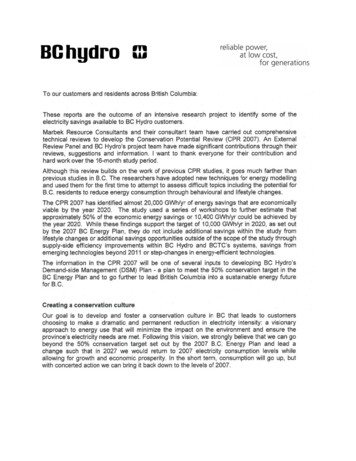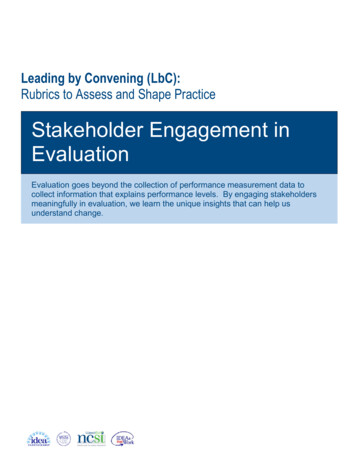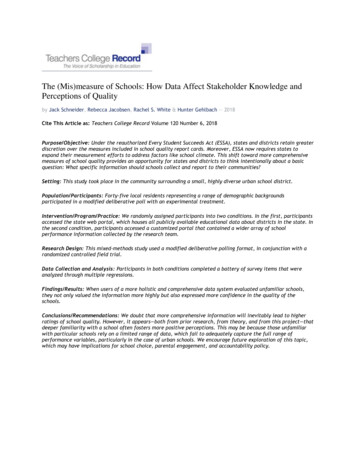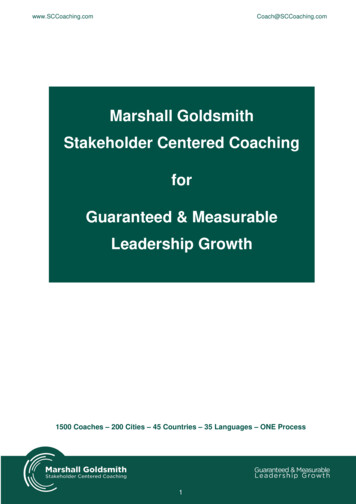
Transcription
Section 2Stakeholder AnalysisGuidelinesKammi Schmeer
Section 2 Table of ContentsIntroduction . . . . . . . . . . . . . . . . . . . . . . . . . . . . . . . . . . . . . . . . . . . . . . . . . . . . . . . . . . . . . . . . 2-1Step 1: Planning the Process . . . . . . . . . . . . . . . . . . . . . . . . . . . . . . . . . . . . . . . . . . . . . . . . . . . 2-3Step 2: Selecting and Defining a Policy. . . . . . . . . . . . . . . . . . . . . . . . . . . . . . . . . . . . . . . . . . . 2-5Step 3: Identifying Key Stakeholders . . . . . . . . . . . . . . . . . . . . . . . . . . . . . . . . . . . . . . . . . . . . . 2-6Step 4: Adapting the Tools . . . . . . . . . . . . . . . . . . . . . . . . . . . . . . . . . . . . . . . . . . . . . . . . . . . . . 2-8Step 5: Collecting and Recording the Information. . . . . . . . . . . . . . . . . . . . . . . . . . . . . . . . . 2-13Step 6: Filling in the Stakeholder Table . . . . . . . . . . . . . . . . . . . . . . . . . . . . . . . . . . . . . . . . . 2-15Step 7: Analyzing the Stakeholder Table . . . . . . . . . . . . . . . . . . . . . . . . . . . . . . . . . . . . . . . . . 2-19Step 8: Using the Information . . . . . . . . . . . . . . . . . . . . . . . . . . . . . . . . . . . . . . . . . . . . . . . . . 2-23Bibliography. . . . . . . . . . . . . . . . . . . . . . . . . . . . . . . . . . . . . . . . . . . . . . . . . . . . . . . . . . . . . . . 2-33Annex 2-A: Sample General List of Stakeholders . . . . . . . . . . . . . . . . . . . . . . . . . . . . . . . . . . 2-34Annex 2-B: Definitions of Stakeholder Characteristics andInstructions for Filling in Stakeholder Table. . . . . . . . . . . . . . . . . . . . . . . . . . . . . . . . . . . 2-35Annex 2-C: Sample Stakeholder Table . . . . . . . . . . . . . . . . . . . . . . . . . . . . . . . . . . . . . . . . . . 2-38Annex 2-D: Sample Stakeholder Interview Questionnaire . . . . . . . . . . . . . . . . . . . . . . . . . . . 2-40Annex 2-E: Sample Information Transfer Reference Chart . . . . . . . . . . . . . . . . . . . . . . . . . . 2-43List of Boxes, Figures, and TablesBox 2.1.Box 2.2.Box 2.3.Box 2.4.Box 2.5.Sample policies . . . . . . . . . . . . . . . . . . . . . . . . . . . . . . . . . . . . . . . . . . . . . . . . . . . 2-5Sample health reform policy definitions . . . . . . . . . . . . . . . . . . . . . . . . . . . . . . . 2-5Potential stakeholder groups for anational-level health reform policy . . . . . . . . . . . . . . . . . . . . . . . . . . . . . . . . . . . 2-6Possible secondary information sources . . . . . . . . . . . . . . . . . . . . . . . . . . . . . . 2-13Sample conclusions on the deconcentration of the MOH . . . . . . . . . . . . . . . . . 2-29
Box 2.6.Sample general strategies for increasingsupport for deconcentration of the MOH. . . . . . . . . . . . . . . . . . . . . . . . . . . . . . .2-30Figure 2.1. The Policy Process . . . . . . . . . . . . . . . . . . . . . . . . . . . . . . . . . . . . . . . . . . . . . . . . .2-2Figure 2.2. Spectrum of Stakeholder Positions . . . . . . . . . . . . . . . . . . . . . . . . . . . . . . . . . . .2-16Figure 2.3. Use All Tools in Filling in the Analysis Table(See Annexes for full versions) . . . . . . . . . . . . . . . . . . . . . . . . . . . . . . . . . . . . . .2-18Figure 2.4. Sample of How to Use PowerPoint to PresentPower/Leadership Analysis Results . . . . . . . . . . . . . . . . . . . . . . . . . . . . . . . . . . .2-24Figure 2.5. Sample Position Map . . . . . . . . . . . . . . . . . . . . . . . . . . . . . . . . . . . . . . . . . . . . . .2-25Figure 2.6. PowerPoint Presentation of Knowledge Data . . . . . . . . . . . . . . . . . . . . . . . . . . .2-27Figure 2.7. PowerPoint Presentation of Key Alliances. . . . . . . . . . . . . . . . . . . . . . . . . . . . . .2-28Figure 2.8. Sample Presentation of Strategies in PowerPoint. . . . . . . . . . . . . . . . . . . . . . . .2-30Figure 2.9. Matrix for Identifying Stakeholders toBe Targeted by Strategies . . . . . . . . . . . . . . . . . . . . . . . . . . . . . . . . . . . . . . . . . . .2-32Table 2.1. Stakeholder Characteristics and Table Titles(full table in Annex 2-C) . . . . . . . . . . . . . . . . . . . . . . . . . . . . . . . . . . . . . . . . . . .2-9Table 2.2. Reference Chart (question numbersthat pertain to each column on the stakeholder table)2-12Table 2.3. Column E of Stakeholder Table . . . . . . . . . . . . . . . . . . . . . . . . . . . . . . . . . . . . .2-15Table 2.4. Columns H and I of Stakeholder Table . . . . . . . . . . . . . . . . . . . . . . . . . . . . . . .2-17Table 2.5. Example Results of Power/Leadership Analysis . . . . . . . . . . . . . . . . . . . . . . . . .2-20
Stakeholder Analysis at aGlanceWhat Is Stakeholder Analysis?Stakeholder analysis is a process of systematically gathering and analyzing qualitative information to determine whose interests should be taken into account when developing and/orimplementing a policy or program.Who Is a Stakeholder?Stakeholders in a process are actors (persons or organizations) with a vested interest in the policy being promoted. These stakeholders, or “interested parties,” can usually be grouped into thefollowing categories: international/donors, national political (legislators, governors), public(ministry of health [MOH], social security agency, ministry of finance), labor (unions, medicalassociations), commercial/private for-profit, nonprofit (nongovernmental organizations[NGOs], foundations), civil society, and users/consumers.Which Stakeholder Characteristics Are Analyzed?The analysis includes such stakeholder characteristics as knowledge of the policy, interests relatedto the policy, position for or against the policy, potential alliances with other stakeholders, andability to affect the policy process (through power and/or leadership).Why Is this Analysis Useful?Policymakers and managers can use a stakeholder analysis to identity the key actors and toassess their knowledge, interests, positions, alliances, and importance related to the policy. Thisallows policymakers and managers to interact more effectively with key stakeholders and toincrease support for a given policy or program. When this analysis is conducted before a policyor program is implemented, policymakers and managers can detect and act to prevent potentialmisunderstandings about and/or opposition to the policy or program. When a stakeholderanalysis and other key tools are used to guide the implementation, the policy or program ismore likely to succeed.
What Are the Steps in Stakeholder Analysis?There are eight major steps in the process:1.Planning the process2.Selecting and defining a policy3.Identifying key stakeholders4.Adapting the tools5.Collecting and recording the information6.Filling in the stakeholder table7.Analyzing the stakeholder table8.Using the informationWhat Can Be Achieved with Stakeholder Analysis?Stakeholder analysis yields useful and accurate information about those persons and organizations that have an interest in health reform. This information can be used to provide input forother analyses; to develop action plans to increase support for a reform policy; and to guide aparticipatory, consensus-building process.To increase support or build consensus for reform, policymakers and managers must takeadditional steps following the stakeholder analysis. In the next phases of the policy process—constituency-building, resource mobilization, and implementation—policymakers and managers should use the information generated by the stakeholder analysis to develop and implement strategic communication, advocacy, and negotiation plans. The other sections of thistoolkit can be used to guide the development and implementation of such plans (see, for example, Section 3: Advocacy Guidelines, and Section 4: Conflict Negotiation Guidelines).
Section 2Stakeholder AnalysisGuidelinesIntroductionIn developing this document, Partnerships for Health Reform (PHR) addresses one aspect ofmanaging the “politics” of the reform process: the need for information on key players whohave an investment in proposed reforms. This is particularly important at the policy formulation and legitimation phase of the policy process (see Figure 2.1). Policymakers and managerscan use stakeholder analysis to identify these key players or “stakeholders,” predict whether theymight support or block the implementation of health reforms, and develop strategies to promote supportive actions and decrease opposing actions before attempting to implement majorreform at the national, regional, local, or facility level.The purpose of this document is to help policymakers, managers, and their working groupsfollow an “objective” and systematic process for collecting and analyzing data about key healthreform stakeholders. It should be noted, however, that even the application of the systematicmethodology incorporated into these guidelines cannot prevent the information from beingsomewhat subjective since stakeholder analysis is based on what stakeholders communicate toanalysts. These guidelines, however, do include suggestions for checking the consistency ofanswers and other mechanisms to ensure that the information is obtained and analyzed asobjectively as possible.This document was developed using a thorough review of the literature on stakeholder analysis, political mapping, and policy process, as well as PHR field experience in conducting stakeholder analyses. (Health reform stakeholder analyses were conducted with PHR support inEcuador and India.) The resulting document, therefore, includes instructions and tools that aresupported by both academic theory and real-world application.These guidelines incorporate a methodology that yields useful and accurate information onhealth reform stakeholders (and can be followed even when conducting a stakeholder analysiswith limited time or resources). The information resulting from the analysis can be used for thefollowing: Provide input for other analyses (i.e., strategic planning, institutional assessment, broaderpolitical analyses)
2-2 Policy Toolkit for Strengthening Health Sector ReformDevelop action plans to increase support for a reform policyGuide a participatory, consensus-building process (by sharing the information obtainedwith the stakeholders and encouraging discussion about how to address the concerns of theopposition).Application of these guidelines is intended to make policymakers and managers more informedabout the political environment surrounding their reforms and better prepared to take action toensure the full implementation of health sector reforms.To increase support or build consensus for reform, policymakers and managers must takeadditional steps following the stakeholder analysis. In the next phases of the policy process—constituency-building, resource mobilization, and implementation (Figure 2.1)—policymakers and managers should use the information generated by the stakeholder analysis to developand implement strategic communication, advocacy, and negotiation plans. The other sectionsof this toolkit can be used to guide the development and implementation of such plans (see, forexample, Section 3: Advocacy Guidelines, and Section 4: Conflict Negotiation Guidelines).Figure 2.1. The Policy Process # ! " "
Stakeholder Analysis Guidelines2-3Step 1: Planning the ProcessDefine the purpose of the analysis, and identify uses for theresults.The first step in conducting a stakeholder analysis is to define the purpose of the analysis, identify the potential users of the information, and devise a plan for using the information. A discussion of these issues should be led by the “sponsor,” or initiator, of the stakeholder analysis.As noted above, information generated from stakeholder analysis may serve several purposes: to provide input for other analyses; to inform the development of action plans to increasesupport for a reform policy; or to guide a participatory, consensus-building process.Other activities, such as strategic planning, institutional assessments, or application of computerized programs like PolicyMaker,1 often require the type of information produced by astakeholder analysis—who the stakeholders are, what their positions are related to a policy,how important they are, and so forth. It may be useful, therefore, to conduct a stakeholder analysis in conjunction with these activities.Policymakers and managers may use the results of a stakeholder analysis to develop theiraction plans. These plans should identify concrete actions, and possibly “behind the scenes”activities, that the policymakers and managers will implement to increase stakeholder support.Finally, policymakers and managers may use the results in open discussions with stakeholders in an effort to build consensus. This allows stakeholders to see where they are relative to others and encourages discussion on how to address the opposition’s concerns. This may be usefulwhen the number of stakeholders is small and manageable and when consensus-building is astated goal of the analysis.Before proceeding with the next steps, the sponsor should ensure that a consensus existsamong the policymakers as to the purpose of the analysis, its proposed users, and the intendeduse of the results.Identify and train a working group.The sponsor of the activity should form a small “working group” (two to four people) whosemembers will be the interviewers and analysts for the stakeholder analysis. The sponsor mayguide the process and serve as a point of reference, or he or she may be a member—even theleader—of the working group.Whenever possible, the working group should represent distinct interests and organizations.This helps prevent the type of biases that can occur when a single person or institution conductsan analysis. Having members with differing points of view can also be helpful in interpretingthe qualitative and, at times, ambiguous data that emerge. If possible, the group should include1. PolicyMaker is a computer program (designed by Harvard University) that organizes stakeholder information,provides guidance on strategies to deal with the stakeholders, and creates effective visuals for presenting theinformation to policymakers.
2-4Policy Toolkit for Strengthening Health Sector Reforma “neutral” person who has no political or other interest in the policy and who is independent ofthe institution promoting the policy. It is also useful to include members who are knowledgeable about the sector, stakeholders, context, and politics related to the policy.The stakeholder analysis process should be participatory, involving all members of the working group from beginning to end. This way, all working group members will be integrated intothe entire process and will gain the experience needed to conduct similar efforts in the future.Integrating all working group members into the process also will increase their understandingof and support for the results and help them accurately translate the interview responses intoanalysis results.It is important that members of the working group are experienced as interviewers and areable to elicit answers to the stated questions without imposing their personal biases. If they haveno previous experience, a day or two of training may be required (such as practice interviewingthrough role playing). The working group members also should be able to review and accurately synthesize qualitative information. In addition, all members of the group should readthese stakeholder analysis guidelines, receive training on the content of stakeholder analysis,and understand the reason for undertaking the analysis.Develop a plan and timeline.Finally, the working group should identify the specific steps to be taken in conducting the analysis (following these guidelines) and establish a timeline for the process. The timeline shouldinclude all major steps in the process, up to and including the final presentation of conclusionsto policymakers. Sufficient time should be allocated for setting up interviews and reschedulingthem in case of cancellations.
Stakeholder Analysis Guidelines2-5Step 2: Selecting and Defining a PolicySelect an appropriate policy.For a stakeholder analysis to be useful, it must be focused on a specific policy or issue. Again,policy is used in this document to refer to any national, regional, local, or institutional project,program, law, regulation, or rule. In most cases, the sponsor of the stakeholder analysis willhave identified a policy, but it is important to ensure that the policy in question is an appropriate topic for a stakeholder analysis before the process begins.The following are some basic criteria for evaluating the appropriateness of health reformpolicies as subjects of a stakeholder analysis: The policy should be specific and “definable.” Policymakersand managers should avoid conducting an analysis on a policy that has not been thought through or is too general to be defined in concrete terms. This is important to ensure that specific interview questions and responses can be developed aroundthe policy.The policy should be socially and politically controversial sothat it merits the investment of resources required to determinewhat aspects are controversial and to whom.The policy should be key to current reform efforts and important enough to justify the resources that will be needed to implement recommended actions that emerge from the analysis.Define the policy.Once a policy is chosen for the stakeholder analysis, the workinggroup should work with policymakers to define the main ideasand concepts. The basic ideas, not the details of the policy, willneed to be explained to the stakeholders later in the process, andsimple, concise definitions will be required. ! " # % & # ' ! % ! ' ! ( # ' ! ) * ' ) # % # # ) ' # ' ' ' , # # ) ' # #
2-6Policy Toolkit for Strengthening Health Sector ReformStep 3: Identifying Key StakeholdersIdentifying the key stakeholders is extremely important to the success of the analysis. Based onthe resources available, the working group should decide on the maximum number of stakeholders to be interviewed. The working group should then follow the steps below to define thelist of stakeholders (beginning with an open list that can be reduced, if necessary).Compile and review existing information.The working group should gather and analyze any written documents related to the selected policy. This will help to identify potential stakeholders and, perhaps, their connection to the policy. ! '
2-2 Policy Toolkit for Strengthening Health Sector Reform Develop action plans to increase support for a reform policy Guide a participatory, consen
